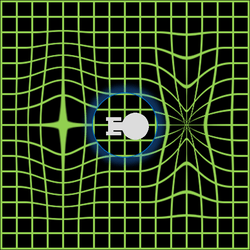Technology in Star Trek
The technology in Star Trek has borrowed freely from the scientific world to provide storylines. Episodes are replete with references to tachyon beams, baryon sweeps, quantum fluctuations and event horizons. Many of the technologies created for the Star Trek universe were done so out of simple economic necessity—the transporter was created because the budget of the original series in the 1960s did not allow for expensive shots of spaceships landing on planets.[1]
Discovery Channel Magazine stated that cloaking devices, faster-than-light travel and dematerialized transport were only dreams at the time the original series was made, but physicist Michio Kaku believes all these things are possible.[2] William Shatner, who portrayed James T. Kirk in the original Star Trek series, believed this as well, and went on to cowrite the book I'm Working on That, in which he investigated how Star Trek technology was becoming feasible.
Subspace

In the Star Trek fictional universe, subspace is a feature of space-time that facilitates faster-than-light transit, in the form of interstellar travel or the transmission of information.[3] Subspace works similarly to the Alcubierre Drive, but obeys different laws of physics. Subspace has also been adopted and used in other fictional settings, such as the Stargate franchise, The Hitchhiker's Guide to the Galaxy series, and Descent: Freespace.
In most Star Trek series, subspace communications are a means to establish nearly instantaneous contact with people and places that are light years away. The physics of Star Trek describe infinite speed (expressed as Warp 10) as an impossibility; as such, even subspace communications which putatively travel at speeds over Warp 9.9 may take hours or weeks to reach certain destinations. Since subspace signals do not degrade with the square of the distance as do other methods of communication utilizing conventional bands of the electromagnetic spectrum (i.e. radio waves), signals sent from a great distance can be expected to reach their destination at a predictable time and with little relative degradation (barring any random subspace interference or spatial anomalies).
Subspace communications have a limit of just over 20 light years before they must be boosted, although this limitation has been "written around" in several storylines.
See also
- Ansible
- Hyperspace (science fiction)
- Star Trek planet classifications
- Time travel
- Warp drive
- Wormholes
- Quantum energy teleportation
Star Trek technologies
References
Further reading
- David A. Batchelor (2009). "The Science of Star Trek". NASA Goddard Space Flight Center.
- C.W. Nevius (2006-06-29). "Astrophysics taking off on Superman". San Francisco Chronicle.
- Keay Davidson (2005-08-29). "Military examines "beaming up" data, people. Critics say its extreme computing, energy needs keep teleportation unlikely for now.". San Francisco Chronicle.
- A. Smith (1991). "Six Dimensions and Star Trek". Science Education. U.S. Department of Energy.
- Star Trek Inconsistencies. Ex Astris Scientia
- Lawrence M. Krauss (1995). The Physics of Star Trek. ISBN 0-06-097710-8.
- Alan N. Shapiro (2004). Star Trek: Technologies of Disappearance. ISBN 978-3-930064-16-8.
- Engineering and Star Trek Micheal Wong stardestroyer.net
External links
- Subspace at Memory Alpha (a Star Trek wiki)